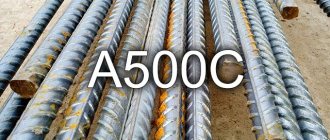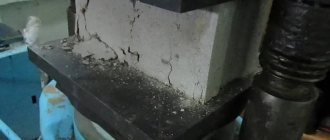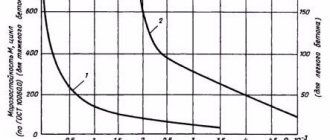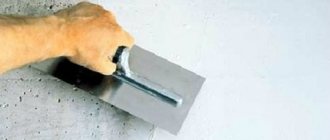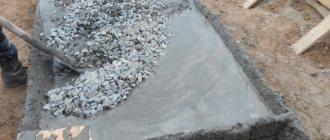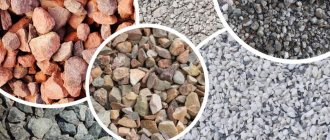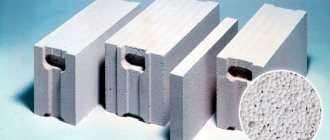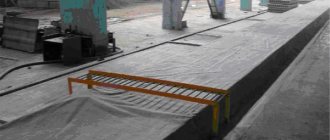Everything in our environment has a base, a frame, a skeleton, which ensures the stability of objects. In construction, such a frame often becomes reinforcement, from which the necessary shapes are made and filled with concrete. Let's look at one of the popular varieties of this material - A500C reinforcement - what class is A1 or A3, and how the classification is generally made. Let's consider the characteristics and application of fittings, what features and advantages they have.
Frame made of reinforcement Source m-investspb.ru
Application in construction
"Armatura" is translated from Latin as "weapons" or "equipment." For construction - from relatively small forms (foundations for private houses, for fences, garages) and to huge civil and industrial facilities - reinforcement is required as an integral part of the frame of reinforced concrete structures.
This steel section is used in the following areas:
- in monolithic construction;
- when laying tunnels;
- construction of bridges and metal structures;
- laying road surfaces;
- production of various concrete products;
- for strengthening foundations, floor slabs and walls.
The reinforcement frame is filled with concrete Source stroysmi.ru
Explanation of markings
Marking of reinforcing bars is usually done using letter designations. The letters indicate the exact method by which the reinforcement was produced. So, for example, the presence of the letter A in the name indicates that the product was made using the hot or cold rolling method. If we compare both methods, it is worth noting that the steel obtained by cold rolling has increased strength characteristics and has greater hardness. The number usually denotes the degree of fluidity of the steel used in the reinforcement; it determines the main difference between the grades of metal. The yield coefficient depends on the maximum stress, which causes the metal to begin to deform. That is, the higher this indicator, the greater the strength of the rod itself. So, for example, A440 steel has a greater safety margin compared to A240.
When building structures made of reinforced concrete, it is necessary to achieve the best strength of the entire structure, using elements with minimal mass. One solution is to reinforce the structure using a steel frame, for the assembly of which reinforcement of various cross-sectional diameters is used. It can be in the form of skeins or rods.
Reinforcement class coding
For convenience, the designations of fittings reflect its classification. By belonging to a certain class, it is normatively determined where the reinforcement should be used, what its characteristics are, and what grades of steel it is made of.
Outdated class designations are defined as A1-A6, and modern ones - A240-A1000.
When designing or constructing, a specialist will learn the necessary information from the grade of material: class, manufacturing method, diameter, special properties.
Diameters in classes
Class coding with corresponding size ranges of rod diameters in cm.
| Outdated markings | Modern marking | Reinforcement diameter (cm) |
| A1 | A240 | 0,6-4 |
| A2 | A300 | 1-8 |
| A3 | A400 | 0,6-4 |
| A4 | A600 | 0,6-4 |
| A5 | A800 | 0,6-4 |
| A6 | A1000 | 1-2,2 |
In reinforcement, the letter “A” characterizes its production method as hot-rolled (rod); with possible thermal hardening or mechanical hardening by drawing.
Yield strength
Subsequent numbers (after the first letter) indicate the minimum yield strength (YS) in N/mm².
On a note! PT is a mechanical strength characteristic of the plasticity of a material, which determines the performance of reinforcement under load, without deformation and destruction. Simply put, the yield strength shows how much force must be applied to the reinforcement so that after the load is removed, the rod does not straighten, but remains bent.
In strength-of-materials, PT is the stress in a material when, after an elastic (reversible) deformation zone, a plastic (irreversible) change begins in the tensile diagram.
Cracks in reinforced concrete Source mpkm.org
See also: Catalog of companies that specialize in calculation, installation and repair of foundations
Designation in codes of additional technical requirements
After the numbers in the marking, there may be letters that, since 2019, correspond to the characteristics of additional technical requirements. The following letters are listed in the fittings:
- C – welded by different types of welding;
- H – increased plasticity;
- E – high plasticity (seismically resistant);
- K – resistance to corrosion cracking;
- U – endurance to repeated cyclic loads;
- P – requirements for stress relaxation.
Associations not by class
In construction, reinforcement is divided into the following types:
- according to profile (smooth, corrugated);
- by orientation in the product (transverse, longitudinal);
- according to the conditions of use (unstressed, stressed);
- by use (structural, installation, operational).
There are also conventional concepts - “soft” (classes A1, A2, A3) and “hard” (high-strength) reinforcing steel. “Soft” steels have lower strength than “hard” ones. But they have better plastic properties and greater elongation at break.
Example of marking of reinforcement Source dokipedia.ru
Armature A 500
To understand in the classification what class A 500 fittings are, you should consider the history of its appearance. Such reinforcement was made as rolled profiles from steel grade 76 for rail processing, from fabric from the dismantling of Russian Railways.
The reinforcement was made by hot rolling, but its parameters differed from the standardized ones. In accordance with the classification that was outdated at that time, it was not possible to determine whether the A500 fittings were of what class - A1 or A3. We established a suitable class in the TU0933-313-36554501-2014 standard.
The independently selected class A500 from rail steel 76 is a non-weldable rolled product with a periodic profile. Here are some characteristics: carbon content 0.71-0.84%, yield strength min 550 N/mm², rod diameters 10-18 mm, bending angles no more than 30°-45°.
That is, the question of what class of fittings A500 contains the answer - A500 is a separate independent class, different from both A1 and A3.
Characteristics and features of A1 fittings
Class A1 fittings have a smooth profile and are made of low-alloy steel (St3sp, St3ps, St3kp). The size of the produced profile can have a diameter from 6 to 40 mm. It is produced using cold rolling. Old marking A1, new A240.
The main advantage of A1 is its high corrosion resistance. It withstands sudden temperature changes and high humidity well. Also, reinforcement with a smooth profile is better welded. Disadvantages include weaker adhesion to concrete.
Features of the A1 brand:
- low price;
- less strength;
- high corrosion resistance;
- good weldability;
- poor adhesion to concrete mortar.
Advantages of class A500C fittings
The A500C is popular among builders because... when using it, cost savings are achieved due to low cost and reduction in the volume of required material for reinforcement. Welded rods are strong, durable, environmentally friendly and reliable, and have multi-purpose use. This class of reinforcement, with large permissible increases in loads in comparison with other classes, ensures the integrity of the welding points.
Welding work during reinforcement Source rblogger.ru
What opportunities to expect:
- It contains less additives (alloying components), so the rods are cheaper, more flexible, and resistant to corrosion.
- It is allowed to replace A400 rods with A500C without calculating the circuit and design, but otherwise, a repeated recalculation is required, and it will entail an increase in cost.
- The bending radius without heating of the A500C reaches 180 degrees; this is not possible for other reinforcing bars.
- A500C is used as an anchor element (anchor) and for a mounting loop due to its high strength and resistance to dynamic loads.
- Retains its performance characteristics for a long time (more than 50 years without contact with water and chemicals) even at temperatures down to -55 degrees Celsius.
A3 or A500C
Many online publications publish information that these are the same type of fittings. In fact, these types of rolled metal are made from different metals and have visual differences.
Class A3 fittings are produced in accordance with GOST 5781-82. Material – low-alloy steel grades 35GS, 25G2S or 32G2Rps. It is often labeled as A400 due to its yield strength of 400 N/mm2.
Figure 2. A3 fittings
Class A500S fittings are produced in accordance with STO-ASChM 7-93 and GOST R 52544-2006 from low-carbon steel with the mandatory addition of:
- silicon;
- manganese;
- phosphorus;
- sulfur;
- nitrogen;
- copper
The quantity of these elements is regulated by GOST.
Due to the fact that the reinforcement of these classes is made of different steels, there are significant differences in their application. It is forbidden to weld the A400 fittings; the connection is made only with the help of a binding wire. But the letter C in the A500C marking means that it is allowed to use a welding seam in cross-shaped joints. This was achieved by reducing the amount of alloying additives in steel.
Externally, these two types of fittings are also different. The A400 necessarily has longitudinal ribs, and the transverse protrusions are located along helical lines that have right entries on one side and left entries on the other. The transverse protrusions are connected to the longitudinal ribs.
Longitudinal ribs in the periodic profile A500 are not a mandatory element and are available in hot-rolled and thermo-mechanically hardened versions. Cold-deformed rolled products can be three-sided crescent-shaped or four-sided segmented. In this case, there are no longitudinal ribs. In the case of longitudinal ribs, the transverse protrusions are located less frequently than in A3 and are not connected to them.
Figure 3. A500S fittings
Briefly about the main thing
The strength and durability of reinforced concrete structures is ensured by a reliable hidden frame - reinforcement.
A500C is a dedicated class of reinforcement – not A1 and not A3. It differs significantly from A1 – both externally and in characteristics. In terms of technical and chemical characteristics, A500C is preferable and more versatile than A3 (A400), due to its weldability, strength, and resistance to any type of load.
The feasibility of using reinforcement material is determined at the design stage, after calculations based on many factors. Knowledge of technical requirements, GOST and standards, types and properties of reinforcement, steel grades, and experience in the specifics of their use in construction are important.
Corrugated fittings 25G2S
In view of this, as well as the significantly excessive strength of this alloy for less massive structures, it was decided to increase the variability of materials. Thus, the second figure in our story appears on the stage - corrugated fittings 25G2S, the composition of which was slightly shuffled, namely, the ratio of manganese and carbon increased in favor of the first.
This made it possible to increase the weldability of the material, but reduced its strength. The game was worth the candle - 25G2S reinforcement, for a long time found true popular love, becoming the most popular alloy for fittings.
Corrugated fittings 35GS
Let's start in order: in the beginning there was a word, or rather the designation of the alloy - 35GS, which, in its composition with alloying elements, a high content of manganese, which guarantees increased flexibility, and carbon, which strengthens the alloy, made it possible to increase the height of construction - to become “closer to the sky.”
Everything would be fine, but the weldability of corrugated reinforcement of steel grade 35GS leaves much to be desired, so more time, material and money had to be spent on creating structures.
Bottom line
Thus, the bottom line is that we have 3 classes of reinforcement, with different strength characteristics, easily welded and absolutely not allowing such actions, plastic like a Bolshoi Theater ballerina and truly “wooden”. All of them are good and in demand in their own way; the variability of choice allows you to calculate and make the optimal choice according to all characteristics, for any project.
Many mega projects require the development of new solutions; thanks to new projects, new building materials are being developed.
This is exactly what the new type of reinforcing steel A400 has become. Return to list
What to choose?
The difference in price between reinforcing bars of grades A1 and A3 is no more than 30%. Despite the much lower quality (hardness and strength), many users, when it comes to non-critical structures, without which the building or structure would collapse, prefer class A1.
The scope of application of both is quite diverse - craftsmen build structures in which one of them complements the second.
A1 is a universal option. It is used to construct concrete rings for the well, slabs, beams and blocks. A1 reinforcement is used for pouring concrete screed, small reinforcement - 6 mm - is used for finishing facades. For foundations, A1 reinforcement is used as a base and as auxiliary elements. The latter may have a smaller cross-sectional diameter.
A3 is a solution where the increased strength of the supporting structure comes to the fore: walls, foundation, frame-monolithic base, located in the corners and between floors. It is designed to withstand high loads - for example, when the weight of the entire building presses on the foundation. A3 showed excellent performance in casting reinforced concrete interfloor slabs. It strengthens the frame mounted from A1 reinforcement. Composite mesh - from A1 and A3 - provides optimal strength and stability at an average cost of this product. Thus, both classes of reinforcement are used for the construction of balconies.
Reinforcement grades other than A1 and A3 are also widely used. They are mainly produced as ribbed rods. They have less resistance to rust. So, A2 is low-alloy: this feature reduces its cost, and for a lower price the user pays with less strength. A2 fittings are suitable for one- and two-story private houses and low-rise office buildings.
Reinforcement A4, A5 and A6 are required in high-rise construction, where the loads from all floors reach impressive values.
Users choose between rods and coils: the first are no longer than 12 m, and after work there are trimmings; the latter immediately allow you to cut a piece of the desired length. The disadvantage of the skein is the need to straighten the cut segment. A coil is used when the length of the unwinding rod is impressive - tens or more meters, and welding 12-meter rods is impractical. The existing differences will help, based on the calculations made, to immediately select fittings in the optimal design, without overpaying for steel, without which you cannot build a single capital structure.
What does the cost of A3 fittings consist of?
First of all, when calculating the cost of rolled metal, production costs and transportation costs are taken into account. However, the final price formation is most often influenced by the markup of the chain of intermediaries. After all, most companies simply resell goods, trying to make it as profitable as possible for themselves. Unlike similar entrepreneurs, he directly cooperates with large metal plants in the Russian Federation. We have entered into an agreement with several factories, so we receive products at very low prices. Consequently, its sale is carried out at a price favorable to buyers. Working with us, you will always receive high-quality steel reinforcement in the right quantity and at an affordable price.
Material of manufacture
There are differences between reinforcement A1 and A3 in terms of the type of steel used. Typically, steel with a low carbon content in its composition is used for the manufacture of materials. For the manufacture of A3 reinforcement, steels with increased ductility and low carbon content are used. A1 reinforcement is made from stiffer and harder steels. Also, according to GOST, variety A1 should not have corrugation.
The cross-sectional diameter of the reinforcement bars, regardless of the profile, usually varies between 8-25 millimeters. When constructing larger structures, such as bridges and high-rise buildings, reinforcement with a diameter of 40 millimeters is used. The composition of the material with a smaller cross-section includes mild steel that is more deeply purified from impurities. For large diameter fittings, any type of steel with a low carbon content can be used.
